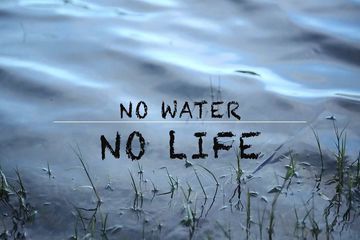No Water, No Life!
My distant relative in Pune was curious when I told them that our society recently opened a swimming pool this May. "Are you guys not having a water crisis?" he asked. I didn’t have an answer!
Every day I start my day with pictures [thanks to newspapers] of people standing in a long queue waiting for an ounce of drinking water, forced to drink muddy water; I felt a bit guilty when I shared that news of the swimming pool. Could I or you imagine life without water?
But why should we imagine 'Life without Water'?
Well, that’s one of the virtuality people live with; around 75 % of the earth is covered with water and we are mostly under the impression that water is abundant. The hard core reality is that only 2% of water available is categorized under “drinking water or fresh water” and even that is reducing, thanks to the exploitation of our natural habitat! If we look at our own body, we will find –
- 60 % of the human body is made up of water
- 77 % of an infant's body is made up of water
- 80 % is the amount of water we have to drink
- 45 % is the amount of water we sweat or breathe out
- 50 % is the amount of water we drink, but lose through urine
So it seems that there is an “urgent need” to think about “How to Live without Water"!
What Are the repercussions’ if we exhaust all the drinking water available?
Water is the lifeline of Mother Earth, the food cycle, water cycle, human and animal lives are sustained because the earth has water. Scientists are trying hard to find water on other planets, as the presence of water could mean life! So if we exhaust are reservoirs we would have –
- No Drinking Water
- No Food supplies
- Famine
- Dry Earth
- No Vegetation
In short NO Water means NO life.
In 2016 most parts of India were already under severe drought conditions, because we have had scanty rainfall and have already exhausted the fresh water reservoirs’.
So can we think about mixing Hydrogen and Oxygen in a lab to get water?
Theoretically, one could simply mix the hydrogen and oxygen molecule and get water, but till date we have not been able to manufacture “water in a lab”. Seems strange! The reason is that Hydrogen and Oxygen should meet [in scientific terms the orbits of each atom's electrons must become linked], and that is only possible with a sudden burst of energy. So water could be produced, but with an explosion!
In fact, in 1937 a blimp, the Hindenburg, which was filled with Hydrogen when reached New Jersey, due to static electricity caused hydrogen to explode and destroyed the ship in less than a minute. However, this process that produced a lot of heat also generated a good amount of water.
So, to create water for a city like Mumbai, just think about the massive explosion one might have to produce!
What are The Options Available to “Save Water”?
- World Vision India an NGO [non-governmental organization] is in talks with the local authorities in drought-hit states across Uttar Pradesh, Maharashtra, and Madhya Pradesh. The NGO aims to provide relief to drought-hit states with cattle fodder, water, food ration and also take initiatives to construct water tanks, check pumps, and dams and invest in crop diversification schemes to help farmers sustain in harsh conditions.
- Aamir Khan the perfectionist who always inspires us with his social initiatives adopted two drought-hit villages Tal and Koregaon in Maharashtra.
- Akshay Kumar the Bollywood “Khiladi” also contributed a sum of 50 lakh as a helping aid to the drought-hit areas.
- You would be surprised to know that Mumbai School Children after watching a documentary film presented by a journalist, made efforts and collected a sum of Rs 20 lakh to provide helping aid to drought-hit areas.
- IPL, which was in the news to move out of Maharashtra, showed their noble gesture three IPL teams Kings XI Punjab, Mumbai Indians, and Rising Pune Supergiants contributed towards drought relief fund in Maharashtra.
- The Water Train, the initiative that started in January 2013 to provide aid to drought-hit Marathwada, is now serving Latur that has been severely affected by drought. With five lakhs litres of water carried by the water train or Jal Doot, it is the only choice to help people in Latur.
For The Long Term:
Rejuvenating a Dead River
Could we do that? Well, yes The Art Of Living Foundation with its project Jal Jagruti Abhiyan has already revived 16 rivers in the past couple of years. The current project is work in progress in Latur, Jalgaon, Osmanabad, Jalna, Nagpur, Kolhapur, Sangli, Nashik, Satara that may be a life savior for villagers in coming years.
The project is not only about rejuvenating rivers but also working to revive 75 canals, 18 lakes and ponds and one dam in Nashik district in the state.
Rain Water Harvesting
It is one of the cheapest and long-term solutions to make sure that water we receive via rainfall is used. It would lessen the burden on bore wells and maintain a decent level of underground water. In fact in the urban cities where real estate is on a boom, and it should be a mandate to equip the society with rainwater harvesting.
Registration of Bore wells
Individuals have been exploiting underground water too much. But nobody thinks of giving it back, so at one place where rainwater harvesting is important, the government should mandate the bore wells registration as well.
And all this is possible when we all follow the mantra of SAVING WATER! W. H Auden said – Thousands have lived without love, not one without water. So start SAVING WATER!
















